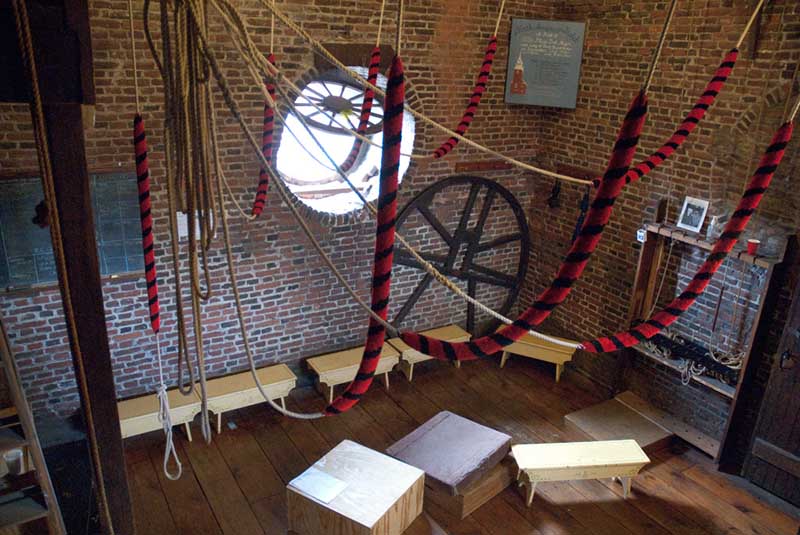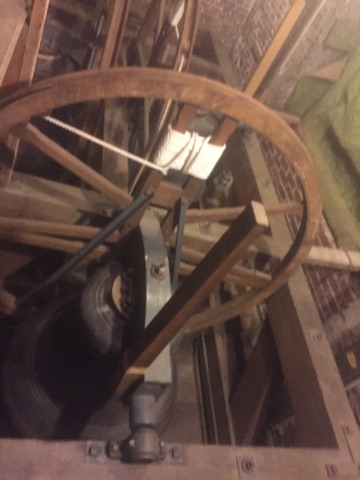Change Ringing Bells: What, How and Why
As a newbie here at Old North, I saw the church bells before I understood them. They are beautiful and impressive—and between two fairly precarious flights of “stairs” that we can’t let visitors climb (that should give you a sense of what I mean by precarious. And “stairs.”) It wasn’t a good time to wonder how they work, what they sound like, or what their backstory is.
That I learned later on a Behind the Scenes Tour—which includes two narrow, steep flights of stairs that visitors are allowed to climb when on a tour and accompanied by an Old North educator.

So what are change ringing bells, and how do they work?
Change ringing bells have their origins in the English countryside, where church bells signaled the hour of the day and called people to church. In the 17th century, the rope and lever ringing mechanisms began to be replaced by wheel mechanisms. If you find yourself asking why, I don’t blame you—but I do have an answer. The purpose of this change was to allow the bells to be rung so that they sound “mouth-up” (that’s up-side-down, or sometimes sideways, to you and me). This meant the sound carried farther and could be heard by people in the countryside farther away from the church. A second reason for the change was that the new mechanism allowed the bell ringers more control over the timing of a bell’s sound.

But what is a wheel mechanism, and how does it allow the bell to be sounded “mouth up”?
Each bell is hung in a wooden wheel in a wooden frame, which you can see in the photo on the left. Ropes sit in an outside channel of the wheel, hanging down to a room below. Here at Old North, the bell-ringing chamber is two floors below the bells, so the ropes must extend two floors downward.

Each rope has a “sally,” which is a colored covering for the rope that marks where the bell ringer needs to catch the rope, and also helps prevent rope burn. These can be seen in the photo of the bell ringing chamber on the right—the sallys are red.
In order to ring a bell, the bell ringer first must make several strong tugs on the rope, which gets the bell into the “up” or “live” position. What this means is that by tugging the rope, the bell ringer turns the wooden wheel enough that the bell hung within that wheel rotates to what I think of as an upside down position—the mouth of the bell is facing upwards toward the sky.
Then, the bell ringer pulls down on their rope, and the momentum of the bell will carry it around to the other side—a full 360 degrees, if the bell ringer allows it to swing that far. It is when the bell makes this rotation, swinging from upwards down and around and back toward the upwards position, that the clapper hits the soundbow (the thick side of the bell) and the bell sounds—facing upwards or horizontally, just as intended for maximum loudness. I found all this easier to understand once I knew that the bell never swings all the way around the top—instead it is more like the motion of a pendulum, or in a more entertaining metaphor, the world’s best swingset (one where you could swing so high you were straight above the swingset, but could never make a loop over the top).
In addition to the original purpose of creating a louder sound, the other purpose served by the switch to change ringing bells was that it allowed the ringers greater control over exactly when the bells ring. Experienced bell ringers can time the ringing of the bell—which occurs roughly ¾ of a second after the rope is pulled—very carefully.
One bell ringer is assigned to each bell, and each bell is cast to ring at a different pitch. The highest pitched bell is called the treble, and the lowest the tenor, but convention has is that the bells are referred to by number, so here at Old North, the treble bell is #1 and the tenor bell is #8. Their ropes hang in a circle around the bell ringing chamber, in order from 1-8 (or 8-1, if you like to be contrary) so that they can more easily be identified by the bell ringers. Bell #1 here at Old North weighs approximately 620 pounds, and Bell #8 weighs approximately 1500 pounds.
Instead of creating melodic music, these bells create a cascade of sounds, which are determined by numeric patterns that serve as the “music” for the bell ringers. The patterns use the numbers of each bell, so for example, the simplest pattern for a set of 8 bells like ours is 1-2-3-4-5-6-7-8. Patterns are used subsequently, so that simple pattern could be followed by any combination of the 8 numbers—there are over 40,000 possible patterns!
Today the bells are rung by the MIT Guild of Bell Ringers every Sunday after the 11am service, and on special occasions like the 4th of July.
But in the centuries since the bells were first installed in 1745, they have been in and out of use. Because the bells had been very expensive, and because they were the first of their kind in North American, our first minister, Reverend Timothy Cutler, could not find experienced bell ringers he could afford to pay. This meant that the bells sat, tragically unused, making no music, for their first five years here. It wasn’t until 1750 that a group of local North End teenage boys signed a contract with the Reverend and the bells were finally rung.
The boys agreed to ring the bells for two hours every Sunday for a year—and in return, they were paid two pennies every week. There is one very famous name on that 1750 contract: Paul Revere. He was 15 when he was a bell ringer here, and it is believed that this experience gave him a familiarity with the church and its steeple that came in handy 25 years later when he needed a signal plan.
Want to become a bell ringer? There are practice sessions most Saturdays! Email bellringers@mit.edu for more information.
